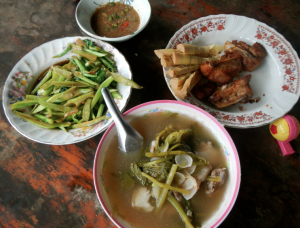Tonight, I find myself in northwest Thailand, in the remote and mountainous province of Mae Hong Son. I’ve been here for six months, as I’m completing a teaching fellowship for Global Playground. I teach English at a middle and high school, which serves 1,200 students from this district and nearby villages. As a proud Pilipina, I am faced with a predicament. The closest Pilipino restaurant is in Chiang Mai (about six hours away from my village), and it is only open for part of the year. Last July, Tita Ann (the owner) and I, shared a brief conversation over the phone, as I was trying to satiate my Pilipino food cravings. Her Chiang Mai restaurant was closed, and she had relocated to Bangkok to run her other restaurant. Naturally, this would happen to a young lady deprived of all Pilipino dishes and dessert. During times like these (hunger, severe stress, intense homesickness and the like), I find myself craving "Sinigang sa sampalok." This delicious and savory soup, flavored by tamarind, onion and kamatis (tomato), is my personal comfort food. Unfortunately, Thai cuisine is known for its chili peppers, sugar, palm sugar, peanuts and fish sauce. Here in the village, my meals consist of noodles, rice, eggs, vegetables, tofu, chicken and pork. Not much variety, since I cannot tolerate spicy dishes.
It was about a month after I had moved to the village that homesickness began to take its toll. I missed my family; before my fellowship, I never went more than two months without seeing them. One day, another teacher at my school flat-out asked me.
“Are you homesick?”, she said bluntly.
“Yes,” I replied without hesitation.
“I’m going to Mae Sariang this weekend to visit my daughter. Do you want to come?” she asked.
I kindly accepted, and that weekend, we drove to her mother-in-law’s home to visit her one-year-old daughter. We went around the neighborhood (i.e. homes scattered among the rice fields), lounged to the sound of the rainfall (it was rainy season at the time), and ate northern Thai food. It is said that northern Thai food is not as spicy as the dishes found throughout the rest of Thailand, though I have to disagree on that. Everything is too spicy for this foreigner.
After one of my naps on the padded mat set up by the TV, I stumbled over to the table. The family had prepared a variety of dishes, and I spotted one that seemed almost too familiar. It was a soup with supple chunks of pork, leafy greens and onions. I doubted it for a mere second, before taking a spoonful and slowly tasting it. It had a sour tinge to it, and in an instant, I smiled. It tasted just like sinigang. I learned that it was called "Pha kaa jaaw," a dish from Chinese influence, also made with tamarind. Now, I can order the dish at restaurants; the cook here at the school also prepares it every now and then, after she learned it was my favorite.
I accepted the teacher’s invitation, and every invitation to join other teachers and staff after that. One of the best pieces of advice I’ve ever heard was, “Always accept an offer.” I’d like to add that you should, at the minimum, consider every offer before you decline it. It may lead you to the "sinigang" you're craving.

